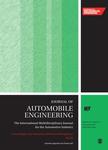版权所有:内蒙古大学图书馆 技术提供:维普资讯• 智图
内蒙古自治区呼和浩特市赛罕区大学西街235号 邮编: 010021

作者机构:RV Coll Engn Dept Mech Engn Mysuru Rd Bengaluru 560059 Karnataka India
出 版 物:《PROCEEDINGS OF THE INSTITUTION OF MECHANICAL ENGINEERS PART D-JOURNAL OF AUTOMOBILE ENGINEERING》 (Proc. Inst. Mech. Eng. Part D J. Automob. Eng.)
年 卷 期:2025年
核心收录:
学科分类:08[工学] 0802[工学-机械工程] 0823[工学-交通运输工程]
基 金:KLS Gogte Institute of Technology Molex India Business Services Pvt. Ltd
主 题:Stress concentration terminal cavity connector polarization
摘 要:Automotive connectors used in safety and infotainment systems employ round sleeve terminals for connectivity. In polarization insertion test, the plastic cavity is subjected to stress concentration at the sharp edges, avoided by introducing edge blends. The test per automotive specifications requires for round sleeve terminals to be restricted from entering the cavity during assembly below a specified force. This condition was not being met and certain mechanical failures were observed at the cavity edges. Why-Why analysis revealed the most likely root cause for this failure as stress concentration at the sharp corners. To overcome this, two re-design ideas were considered. The double edge blend and single edge blend features were thus taken up for the stress concentration study but the same was scarcely reported in literature and thus the development of Stress Concentration Factor curves was identified as the gap. The model was meshed with adaptive refinement near the edge blends in Ansys 2024 R1. The maximum stress was noted down and parametric simulation was run for r/d ratio ranging from 0.01 to 0.25 with steps of 0.01 for D/d of 1.3, 1.2 and 1.15 and chamfer angles of 30 degrees, 45 degrees and 60 degrees. The data was used to consolidate the Stress Concentration factor values and the consolidated curves were developed subsequently. Second order polynomial regression equations and logarithmic best fit curve equations along with respective acceptable correlation coefficients were summarized. 3D surface plots for interaction of parameters were obtained. A comparison of maximum stress values derived from the best fit curves and finite element analysis for various combinations showed a good agreement with a maximum deviation of 6.6%, thereby indicating Stress Concentration Factor (Kr) curves generated in the study can be faithfully used for similar configurations.